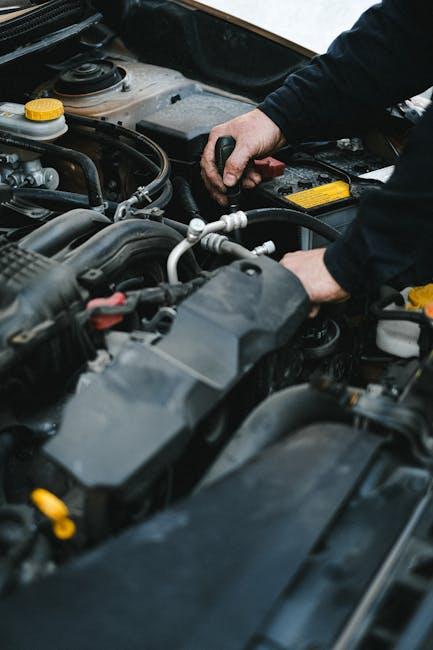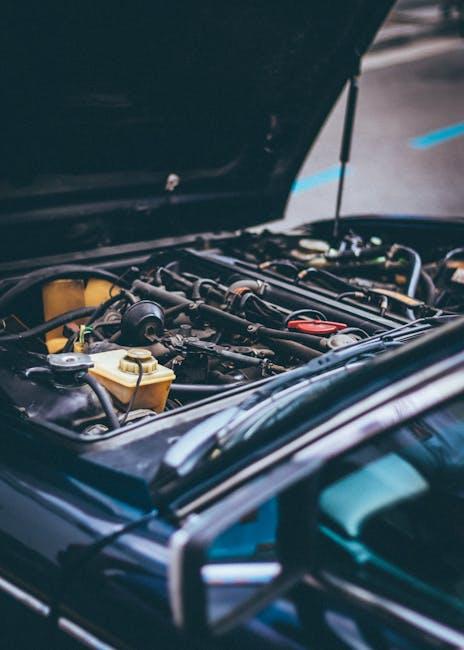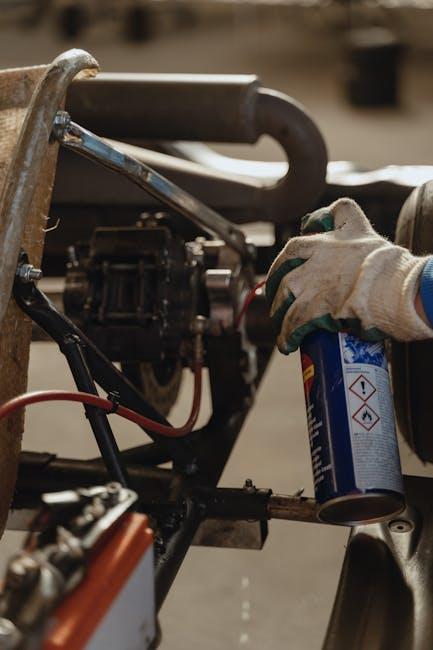Keeping your vehicle in prime condition goes beyond just filling up the gas tank and washing off the grime. Like a well-tuned orchestra, every part of your car requires timely attention to perform harmoniously on the road. Yet, amid busy schedules and countless errands, tracking and scheduling maintenance can easily slip through the cracks. This guide will walk you through practical strategies and tools to stay ahead of your vehicle’s upkeep—ensuring safety, efficiency, and longevity—all without the stress of surprise breakdowns or costly repairs. Whether you’re a meticulous planner or someone who prefers a simple reminder, mastering vehicle maintenance scheduling is key to driving with confidence.
Table of Contents
- Choosing the Right Tools for Effective Vehicle Maintenance Tracking
- Understanding Your Vehicle’s Maintenance Schedule and Why It Matters
- Creating a Personalized Maintenance Calendar That Fits Your Routine
- Leveraging Technology to Stay Ahead of Service Deadlines
- Tips for Keeping Detailed Records and Recognizing Warning Signs
- Partnering with Trusted Mechanics for Long-Term Vehicle Health
- Q&A
- Wrapping Up

Choosing the Right Tools for Effective Vehicle Maintenance Tracking
To manage your vehicle maintenance effectively, selecting the appropriate tools is crucial. Digital apps designed for vehicle tracking offer real-time notifications and detailed service history, making your life easier. These tools range from simple mileage trackers to comprehensive platforms that integrate parts ordering, mechanic appointment scheduling, and fuel economy analysis. When exploring options, prioritize features such as:
- Ease of use: A clean, intuitive interface can save you time and avoid confusion.
- Customization: Ability to tailor reminders for different vehicle types or specific maintenance tasks.
- Data accessibility: Cross-device syncing ensures you never lose track of your records.
Beyond apps, some vehicle owners prefer physical logbooks paired with digital spreadsheets for a hybrid tracking method. If you lean towards manual methods, consider the table below to help organize your maintenance tasks efficiently:
| Maintenance Task | Recommended Frequency | Notes |
|---|---|---|
| Oil Change | Every 5,000 – 7,500 miles | Depends on oil type and driving conditions |
| Tire Rotation | Every 6,000 – 8,000 miles | Enhances tire life and performance |
| Brake Inspection | Every 12,000 miles | Critical for safety |

Understanding Your Vehicle’s Maintenance Schedule and Why It Matters
Every vehicle comes with a meticulously designed maintenance schedule, tailored to safeguard its performance and longevity. These schedules outline critical tasks such as oil changes, tire rotations, brake inspections, and fluid replacements that keep your vehicle running smoothly. Sticking to this schedule is more than just a recommendation—it’s a necessity to avoid unexpected breakdowns and costly repairs. Regular maintenance not only preserves your vehicle’s value but also ensures your safety on the road by preventing mechanical failures before they occur.
To make the process simpler, consider tracking your vehicle’s upkeep with a personalized system. This could be a dedicated app, an organized spreadsheet, or even a classic maintenance notebook. Key benefits include:
- Timely reminders to avoid missed service dates
- Clear records of past repairs and inspections
- Budget management by forecasting upcoming costs
| Maintenance Task | Suggested Interval | Why It Matters |
|---|---|---|
| Oil Change | Every 5,000-7,500 miles | Prevents engine wear and overheating |
| Tire Rotation | Every 6,000-8,000 miles | Ensures even tire wear and better handling |
| Brake Inspection | Every 12,000 miles or annually | Maintains braking efficiency for safety |
Developing a habit of proactive maintenance tracking transforms vehicle care from a chore into a seamless and effective routine.

Creating a Personalized Maintenance Calendar That Fits Your Routine
Start by assessing your daily habits and identifying natural touchpoints where you can integrate maintenance tasks without disruption. For example, if mornings are less rushed, consider setting reminders for quick checks like tire pressure or fluid levels. Using digital tools like calendar apps or specialized vehicle maintenance trackers can sync your schedule with service intervals, ensuring nothing slips through the cracks. Customize alerts according to urgency—routine oil changes might warrant monthly nudges, while more critical inspections could trigger weekly notifications.
Organizing your maintenance tasks into clear, bite-sized goals helps keep your routine manageable. Try creating a checklist with categories like Engine Care, Tire Management, and Interior Upkeep. Here’s a simple example to keep tasks visually organized and easy to tick off:
| Category | Task | Frequency | Reminder Type |
|---|---|---|---|
| Engine Care | Oil Change | Every 5,000 miles | Alert |
| Tire Management | Pressure Check | Weekly | Notification |
| Interior Upkeep | Vacuuming | Biweekly | None |
By blending your vehicle maintenance into your rhythm and using practical tools, keeping your car in peak condition becomes less of a chore and more of a well-organized habit.

Leveraging Technology to Stay Ahead of Service Deadlines
In today’s fast-paced world, keeping up with your vehicle’s maintenance schedule can be a daunting task without the right tools. Digital solutions now make it simple to track every oil change, tire rotation, and brake inspection with just a few taps on your smartphone. Mobile apps and cloud-based platforms offer customized reminders and maintenance histories, transforming guesswork into well-informed decisions. By syncing these tools with your calendar, you ensure proactive care before deadlines slip by, helping prevent costly repairs and unexpected breakdowns.
Embracing technology also means harnessing data for smarter scheduling. Some apps provide insights based on your driving habits, suggesting adjustments to service intervals tailored for your usage patterns. Below is a quick comparison of popular vehicle maintenance apps that combine tracking and scheduling to boost convenience and efficiency:
| App | Key Feature | Notification Type |
|---|---|---|
| AutoCare Pro | Maintenance history archive | Push & Email |
| MyCar Manager | Driving habit analytics | In-app Alerts |
| ServiceSync | Dealer service integration | SMS & Push |

Tips for Keeping Detailed Records and Recognizing Warning Signs
Maintaining thorough records is essential for the longevity and reliability of your vehicle. Start by creating a dedicated maintenance log, whether digital or physical, to note down every service, oil change, tire rotation, and repair. Include dates, mileage, service details, and costs. This organized approach not only helps you stay on schedule but also becomes a valuable resource when diagnosing recurring issues or preparing to sell your vehicle. Keep receipts and service reports in a safe place to back up your log and provide proof of proper care if needed.
Being attentive to warning signs can save you from costly repairs down the road. Pay attention to unusual sounds, dashboard indicator lights, or changes in the way your vehicle drives. Use this checklist to stay alert:
- Strange noises: squealing brakes, engine knocks, or hissing sounds
- Warning lights: check engine, oil pressure, or tire pressure monitoring system
- Fluid leaks: puddles or spots under your car
- Handling changes: pulling to one side, vibrations, or difficulty steering
| Warning Sign | Possible Cause | Recommended Action |
|---|---|---|
| Check Engine Light | Emissions or engine issues | Visit mechanic for diagnostics |
| Brake Noise | Worn brake pads | Schedule brake inspection |
| Unusual Vibrations | Wheel alignment or tire issues | Perform tire check and alignment |
Tracking these details and recognizing early warning signs empowers you to take timely action, keeping your vehicle safe and enhancing its performance on every journey.

Partnering with Trusted Mechanics for Long-Term Vehicle Health
Building a reliable relationship with a trusted mechanic is crucial for ensuring your vehicle stays in peak condition over the years. These professionals offer more than routine check-ups; they become your go-to resource for expert advice tailored to your car’s specific needs. By collaborating closely with a knowledgeable mechanic, you gain personalized insights that help you prioritize repairs, avoid unnecessary services, and extend the lifespan of your vehicle. Don’t hesitate to ask questions and seek recommendations on parts, service intervals, and driving habits that optimize performance.
When selecting a mechanic, prioritize qualities such as transparency, certification, and solid customer reviews. A dependable mechanic will keep detailed records of maintenance history and provide clear explanations of any issues found during inspections. Utilize the following tips to enhance your partnership:
- Share vehicle history so they can detect patterns or recurring problems early.
- Schedule routine inspections before long trips to catch hidden issues.
- Request maintenance reminders via calls, emails, or apps to stay ahead of deadlines.
- Discuss warranty and recall updates to ensure your car remains compliant and safe.
Q&A
Q&A: How to Track and Schedule Your Vehicle Maintenance
Q1: Why is tracking vehicle maintenance important?
A1: Tracking your vehicle’s maintenance helps prevent unexpected breakdowns, extends the life of your car, and ensures safety on the road. Regular upkeep keeps your engine happy, your tires rolling smoothly, and your brakes responsive, saving you money and stress in the long run.
Q2: What’s the best way to start tracking my vehicle’s maintenance?
A2: Begin by gathering your vehicle’s owner manual and noting recommended service intervals. From there, you can use a maintenance logbook, spreadsheet, or smartphone app designed to track oil changes, tire rotations, brake inspections, and more.
Q3: How often should I schedule routine maintenance?
A3: Service intervals vary by vehicle and driving conditions, but a general rule is every 3,000 to 7,500 miles for oil changes and tire checks every 6,000 to 8,000 miles. Always consult your manual for specifics—some newer cars have longer intervals thanks to advanced technology.
Q4: Are digital tools helpful for vehicle maintenance scheduling?
A4: Absolutely. Digital tools can send reminders, store service history, and even forecast upcoming maintenance needs based on mileage and time, making it easier to stay ahead without juggling paper notes or relying on memory.
Q5: What should I include in my maintenance tracking system?
A5: Track the date, mileage at service, type of service performed, costs, and any observations or recommendations from your mechanic. A detailed record empowers you when selling your car or diagnosing future issues.
Q6: Can neglecting maintenance affect my vehicle’s value?
A6: Yes, a well-documented maintenance history can increase your vehicle’s resale value by showing prospective buyers you cared for it properly. Conversely, neglecting regular maintenance can lower the lifespan and value of your car.
Q7: What if I’m not sure when maintenance is needed?
A7: Most modern vehicles have a maintenance reminder light or message on the dashboard. Additionally, your mechanic can assess wear and help set a tailored maintenance schedule suited to your driving habits and environment.
Q8: How can I balance scheduled maintenance with unexpected repairs?
A8: While scheduled maintenance is proactive, staying aware of how your vehicle sounds, handles, and looks can alert you to problems early. Record any unexpected repairs alongside routine maintenance for a complete picture.
Q9: Is it worth scheduling maintenance during specific times of the year?
A9: Seasonal maintenance, like checking your coolant before summer or inspecting your battery before winter, can be smart. Aligning maintenance with seasonal changes prepares your vehicle for different weather challenges.
Q10: Can DIY maintenance be part of my schedule?
A10: Definitely! Simple tasks like checking tire pressure, topping up fluids, or replacing windshield wipers can be done at home. Including DIY tasks in your maintenance log can help ensure these small but important checks aren’t overlooked.
Tracking and scheduling vehicle maintenance may seem like a chore, but with the right system and a little routine, it becomes a smooth drive toward a reliable and long-lasting vehicle.
Wrapping Up
In the journey of vehicle ownership, staying on top of maintenance is your trusted co-pilot. By effectively tracking and scheduling each service, you not only extend your vehicle’s lifespan but also ensure safety and peace of mind on every mile traveled. Embrace the tools and tips that fit your style, and watch how a little planning transforms routine upkeep from a chore into a seamless part of your driving adventure. After all, the road ahead is best enjoyed when your vehicle is ready for every turn.
